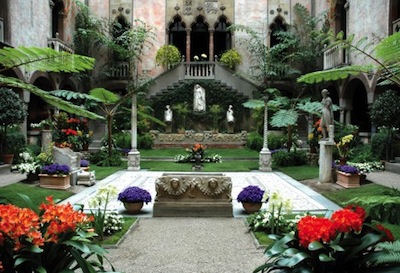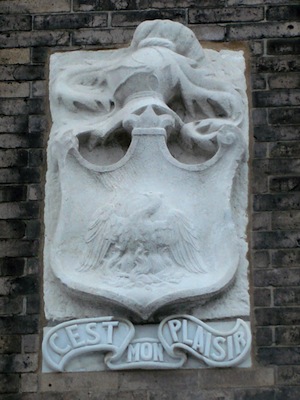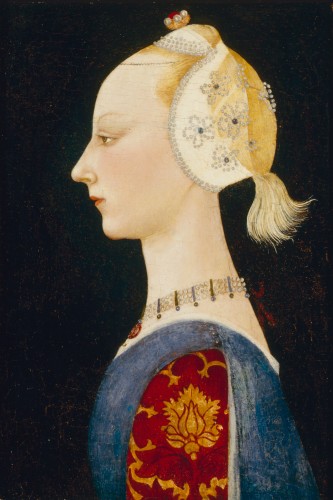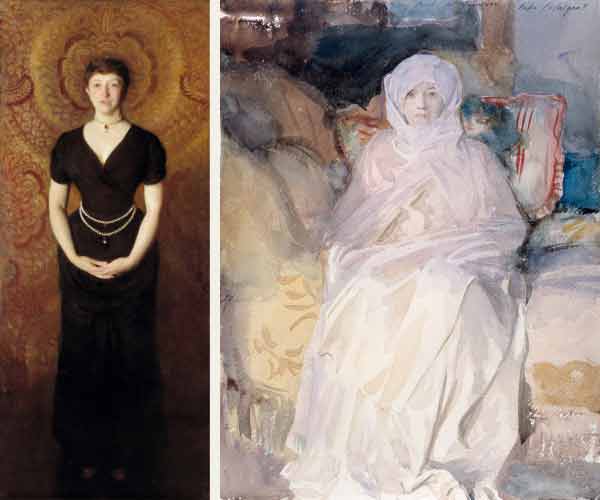Five Excerpts from
The Memory Palace of Isabella Stewart Gardner

1. FROM THE PREFACE
Writing about the life of someone both long dead and flamboyant offers to be an ambiguous pleasure. On the one hand, the past is an impenetrable mystery; on the other, colorful evidence is irresistible. In the case of Isabella Stewart Gardner, the evidence even has its own institution: Fenway Court, the museum she built and filled, a very personal monument to art and to her own memory. Every year on her birthday, April 14, a Mass is still said in the chapel she installed on the third floor of that palace. I attended the seventy-ninth performance of the ritual, where I sat beside a long wooden carving that unfurls the injunction to say only good of the dead. I heard the little bells, smelled the incense; around me were prayers, responses, sunlight and quiet, the fountain splashing in the courtyard below. Se monumentum requieres, circumspice, said the priest. He was referring to Christopher Wren and his St. Paul’s Cathedral in London, but also to the woman in whose house we were sitting. We have to thank her, he concluded cheerfully, for giving us something to talk about.
How to talk about her, though? Biography, however full of interesting and well-researched anecdote and information, is always bound by the shape of human life–the achievements and relationships duly noted, the end always known in advance. The shape of Isabella Gardner’s house/museum, however, invites the visitor to circle–around the courtyard, then through the second and third floor rooms and galleries that open their Venetian Gothic windows to that skylit space. Fenway Court invites random lingering and also returning again and again.
To find Isabella I have accepted that invitation, and imitated that process: to make her live in my imagination I have circulated around and among her objects and her friends; I’ve lingered with her art in the company of contemporary artists. To draw closer to her great project and to the art she left us, even as she herself recedes further into the past, I had to find a literary form that was different from biography. I had to find a way to approach my subject that was faithful both to the mysteries of her absence and to those of my own perceptions and associations, filling her palace with memories of my own.

2. C’EST MON PLASIR
Inscription over central entrance portal
When this nouveau European palace, derived from architecture that rises beside the Grand Canal in Venice, rose itself in the urban wasteland across from Boston’s marshy Fenway in 1902, it was a breathtaking display of self-assertion. The Boston Fens were and remain a testament to the ingenuity of Frederick Law Olmsted in turning a stagnant wetland into emerald parkland, but they are not the Grand Canal; their waters and reeds, lawns and gardens have not been honored by Isabella’s inward-turning monument, with its palazzo façades surrounding its own interior courtyard. To step into its world is to meet a legacy of luxury and willfulness, aesthetics inextricable from personality. She put this here so that her life, her pleasure, her living presence would stay on where she put her foot down, no matter that her literal remains would end up in a family tomb in Mount Auburn Cemetery in Cambridge. What she loved, who she was, what all this meant: fragments shored against ruin. …
Now my own Isabella, my own nineteenth-century world, my own fragments, have been mixed with hers. My language alone is carrying the story now, the digressions and details of my days spent in hers: my objections and discoveries, the places where I am surprised or tickled, the mysteries of spectatorship and of the irrecoverable past. All this looking and hunting is now a collection that’s been my own pleasure to order and arrange, even as time carries my curious researches ever further from their object. Wandering from painting to carving to dishes to manuscripts, from history to fiction to letters and memoir, I assemble my fragments; then I enter her house, no longer a stranger.

3. A YOUNG LADY OF FASHION
Painting on wood by Paolo Uccello (15c) in the Long Gallery
The Gardners and the Adamses were friends in Europe–Isabella introduced Clover to her favorite dressmaker, Worth, a visit to whose studio was a sort of theatrical event. Skeptical about the fuss, Clover was nevertheless delighted when the first gown showed up: It “not only fills my small soul,” she admitted, “but seals it hermetically.” Leaving an English soirée together, Mrs. G. and Mrs. A. stood together in the vestibule waiting for their broughams (pronounced like “brooms” but meaning a particular kind of horse-drawn vehicle appropriate for conveying ladies dressed in Worth gowns around town), and entertaining themselves with sartorial and sociological observations. “Down come an elderly female in black, followed by a jolly-looking, very fat one, and the Britons fall back on either side and bend their sovereign-loving knees, because it’s the Grand Duchess of Mecklenberg-something and her sister Mary of Teck,” Mrs. A writes to her father.
Two lively young women from Boston; a lighthearted moment in a London vestibule–Clover’s observations have an irreverence that transcends the fashionable moment. Uccello’s painting in Mrs. Gardner’s third floor gallery, though entirely of its Renaissance Florence, has a similar gaiety and refusal of routine piety. His young lady is bright with reds and blues and gold; hers is not the profile of an angel. Uccello is famous for his pleasure in the discovery of perspective, for his clear-minded wit. How pleasing, then, to see that spirit in another form, another century, in the colors of epistolary language.
Yet neither of these young ladies from Boston was a stranger to suffering, as it happens. Isabella had already lost a passionately loved baby son and been advised to have no more children. Clover had lost her freethinking, emotionally intrepid mother when still a child. Nor would she herself ever have a child. But in this era of the great culture raids on Europe, both plunged happily into some of the great pleasures attendant on a great raid. For Isabella Gardner, the city of her heart was Venice, where she and the indulgent Jack rented a palazzo and invited their friends to visit. The Adamses explored Paris, whose delights Clover professed herself unequal to describing or properly appreciating, but I think we can get the flavor well enough when she says, “We never dine in our hotel, but browse far and wide and can tell you the merits of half the restaurants in Paris.”

4. THE RAPE OF EUROPA
Painting by Titian (16c) in the Titian Room
I heard one of the guards at the doorway into the Titian Room describing Isabella as having “that big mind–she knew exactly what she wanted to do.” A retired art educator, he went on to explain that Titian’s subject [The Rape of Europa] was considered very erotic in her time: the way the painter caught the moment of abduction as if it had been an irresistible shot by a morally lax photojournalist. Then he pointed out on a stand nearby the small painting of “Christ Carrying the Cross,” the work of an artist in the circle of Giovanni Bellini. She used that, he said, to calm herself down after spending time with the so stirring Titian. Is this the guard’s own way of completing the artwork–perhaps finding the way Christ seems to make direct eye contact with the viewer a more important conjunction than the unfurled silk? Are the paintings together because they were purchased during the same heady period in 1896-97 (when the almost-Bellini was thought to be by Giorgione)? Or does the very quirkiness of the whole display preclude completion? The patterning around the Titian includes so many other objects–does it flow from personal associations with the dress or the pleasure of ownership, or other memories of delight comparable to that given by the painting? Is this just a tease, or is there also a tea ceremony? What is the conversation going on here, and how am I part of it?

5. PORTRAIT(S) OF A LADY
Sargent painting in the Gothic Room & Sargent watercolor in the Macknight Room
There are actually two portraits by Sargent in the Gardner Museum, the second and smaller one done less than two years before her death, both showing Isabella at the center of at least her own life, if not all of Earth and Heaven. In both her figure is very much the whole story, with no cranes or peonies or other coded philosophical commentary.
In the one known as Portrait of a Lady she is standing directly facing the viewer wearing a long dark dress with short sleeves and a heart-shaped neckline, the point of the heart just low enough to show a bit of cleavage. Behind her is a series of golden circular patterns, like a mandala or the background of a thirteenth-century religious painting. The way the design works, she appears to have both a crown on her head and a halo around it. In this one the performance assumes the viewer’s direct engagement: the lady looks straight out from above the heart-shape, and the black velvet dress is merely background for her bare arms and the doubled rope of pearls circling her famous waist. (Morris Carter’s biography says the portrait took nine tries to complete–to Sargent’s despair–but that she was enjoying it.)
The theatricality of this image is matched in the later portrait, a small watercolor in which the sitter is swathed in white fabric from head to foot, sitting on a divan, a pillow supporting her back. This one is called Mrs. Gardner in White, and has a slightly exotic feel to it. She is covered except for her face, but it’s as if the face is only momentarily exposed, as if she were an Arab woman or a figure from antiquity. There’s no hint that by this time she had been partially disabled by a stroke, and was in fact propped on the pillow. On the other hand, the portrait does seem to show a face being absorbed by surroundings that are themselves thinning out. Where in the earlier portrait her flesh came forward from deep gold-red and vivid black, here the red is a few streaks on the pillows, the gold a muted yellow barely sketched on the slipcover. The shadows on her robes shade into deeper shadow behind her. The face is ageless, but it’s clearly a function of the painter’s tact, not the lady’s religious practices. By this time she was in her eighties, and for Sargent a lady’s face was not the place to demonstrate his mastery of realist technique. …
The later portrait is about as far away from this as the museum allows. Sargent’s watercolor is in the Macknight Room, on the first floor, near the front door. Sargent lived in it while he was painting the portrait upstairs. As it can be easily closed off when the museum is short of guards, often it’s not even open, so it retains an impression of being a sort of inner sanctum. You enter through a double set of doors, the inner one with a portrait on it of Macknight himself. Dodge Macknight was a painter whose work she liked, bought, and hung–enough of it to give the room its name. In spite of its four tall windows the room seems small and intimate. And in spite of its sparse furnishings, rather crowded.
When Sargent had finished this portrait Isabella propped it on a bookcase where she could see it from her seat in front of the fire. There it remains, one among many objects on the bookcase. Standing before it you have to tilt your neck up, and stand on one side to avoid the reflection from the glass covering it.
As I am studying the aged Isabella sitting against her pillows staring into the future that will not be hers (despite her efforts here), the guard comes over to intensify my experience. “That’s Mrs. Gardner,” he tells me in a deep Russian accent, “and she was painted right here in this room.” In fact, he goes on, she was sitting right there, on that couch. He points to a low settee with a caned seat under an opposite window. It is clearly not the comfy, pillow-strewn couch in the painting. My doubtful noises spur him to discover internal documentation–the bit of frame behind her, which he says is the window, but now looks to me like part of another painting (an observation I keep to myself). Warming to his theme, he makes a perpendicular gesture toward the window behind the settee. “So,” he informs me in Slavic basso, “you have the opportunity to touch history.” That is, of course, what I am trying to do, and I put up no further resistance to his misinformation.